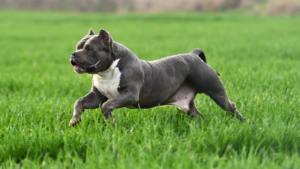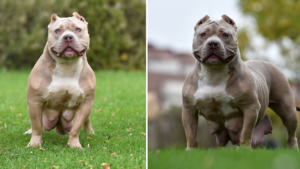Table of Contents
Toggle
Thinking about welcoming an American Bully Puppy into your home? These affectionate, muscular pups make fantastic companions, but like any breed, they have unique needs and characteristics. Understanding these will ensure your furry friend thrives in your loving care.
Developed in the United States between the 1980s and 1990s, the American Bully is a relatively new breed. Created by combining American Pit Bull Terriers, American Staffordshire Terriers, and other bulldog breeds, the aim was to retain the loyalty and stability of the Pit Bull Terrier while achieving a more robust build and gentler disposition.
American Bully Puppies are known for their sturdy, muscular appearance. Broad chests, well-defined jaws, and strong legs define their physique. Despite their tough looks, these pups are incredibly affectionate and loyal, making them excellent family dogs with a gentle nature towards children and other pets.
American Bullies come in various types, each with distinct physical attributes:
When selecting your American Bully, consider factors like temperament, breeder reputation, and the puppy’s specific needs. Reputable breeders provide health clearances and allow you to meet the parents, ensuring a well-bred, healthy pup.
Before bringing your puppy home, puppy-proof your living space. Remove any hazardous items and create a safe, comfortable area for your furry friend to rest. Essential supplies include food and water bowls, a comfortable bed, toys, and grooming tools.
A balanced diet is crucial for your American Bully Puppy’s healthy growth. Choose high-quality dog food rich in protein, vitamins, and minerals. Establish a feeding schedule to keep your puppy active and healthy. Typically, puppies need more frequent meals than adult dogs, so plan for three to four meals a day.
Training is essential for your American Bully Puppy’s development. Start with basic obedience commands like sit, stay, and come. Socialization is equally important; expose your puppy to different environments, people, and other animals to build confidence and sociability.
Regular veterinary check-ups are vital for monitoring your puppy’s health. American bullies can be prone to certain health issues, like hip dysplasia and skin allergies. Ensure your puppy receives all necessary vaccinations and preventative care to keep them in optimal health.
American Bully Puppies are energetic and require regular exercise to stay healthy and happy. Daily walks, playtime in the yard, and interactive toys are great ways to keep your puppy active. Engaging in activities like agility training can also be a fun way to exercise your pup.
Regular bathing and brushing help maintain your American Bully Puppy’s coat’s health and shine. Additionally, keeping their nails trimmed and ears clean will prevent infections and other health issues.
American Bully Puppies are known for their friendly and outgoing nature. However, like any dog, they may exhibit certain behaviors that need to be managed. Understanding their behavior and providing consistent training will help address any issues like chewing, digging, or barking.
Building a strong bond is crucial for their well-being and your relationship. Spend quality time with your puppy, engage in play, and provide positive reinforcement during training. This will help create a trusting and loving bond.
If you plan to travel with your American bully puppies, ensure their comfort and safety during the journey. Use a sturdy travel crate and make regular stops for exercise and bathroom breaks. Familiarize your puppy with the car gradually to reduce travel anxiety.
Owning an American Bully Puppy is a rewarding experience with its unique set of challenges and joys. By understanding their needs and characteristics, you can provide a loving and nurturing environment for your new furry friend. With proper care, training, and attention, your American Bully Puppy will grow into a loyal and affectionate companion, enriching your life with their gentle giant spirit.

Raising an American Bully puppy is a rewarding journey, and ensuring they develop into well-rounded, confident adults requires early and consistent effort. Here are some key areas to focus on:

Owning an American Bully puppy is a delightful experience. By understanding their unique needs and providing proper care, you can help them thrive and become a loyal and loving companion. Remember, every aspect of their life, from nutrition and healthcare to training and socialization, plays a role in their development. Embrace the journey and enjoy the bond that grows stronger with each passing day.
Lorem ipsum dolor sit amet, consectetur adipiscing elit, labore et dolore magna aliqua. Eget aliquet nibh praesent tristique
Subscribe now to keep reading and get access to the full archive.